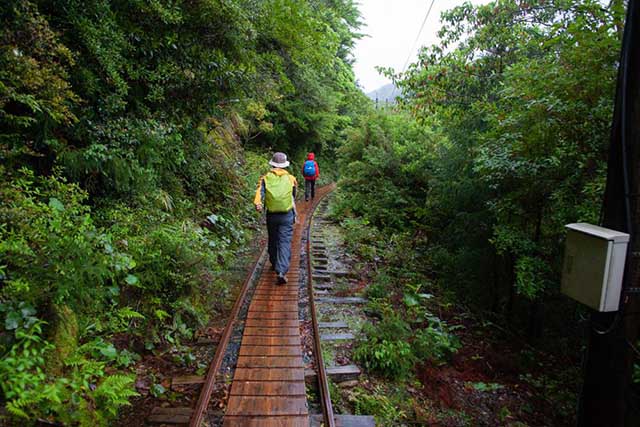
Yakushima, one of Japan’s southernmost islands, is best known for its lush greenery and intense mountain climbing. Hiking is the main activity on the island and every year thousands of tourists, both Japanese and foreigners, hike through the island’s mountains. Hikes range from short walks to days-long journeys, all traversing unadulterated terrain. Be sure to keep in mind these tips to create a safe experience for visitors and to protect Yakushima’s precious landscape.
-
01
Equipment and weather
![Equipment and weather]()
Equipment and weather
Known as Japan’s wettest destination, the weather in Yakushima is notoriously humid and moist. Waterproof equipment is highly recommended, such as waterproof hiking boots and light rain jackets or ponchos. Tsuyu, or rainy season, occurs in June and July, and typhoons rage throughout October. When it is not raining, summer is the warmest season, with temperatures reaching 30 degrees. Light snow in winter can cover the mountainous trails but the adventurous find that it is still safe to hike. Autumn and spring are the best times to visit, with autumn’s dry weather and spring’s cherry blossoms. No matter the season, always bring waterproof gear, especially sturdy, waterproof hiking boots. The trails are situated on wild terrain and it is easy to trip on fallen tree branches or slip in mud. A hiking backpack is also recommended. Most of the hikes are day trips in which hikers may be walking the entire day. Lightweight athletic backpacks with plenty of straps will help keep hikers happy and moving.
![Equipment and weather]()
Equipment and weather
-
02
Food and the importance of breaks
![Food and the importance of breaks]()
Food and the importance of breaks
It is very important to bring food on long hikes. Most hikes, including the most popular trail to Jomon Sugi, take many hours to complete, some up to ten. The trails require rigorous exertion, such as scaling steep mountains or jumping over large rocks. Be sure to pack plenty of nourishment so you can keep up your energy for both the hike out and the return trip. Food is only available in towns or near hotels and guesthouses. It is recommended that hikers bring a reusable water bottle that can be refilled at the natural water fountains or waterfalls on the journey. Breaks are especially important for both short and long hikes. The trails often run uphill and can be exhausting even for the experienced trekker. Taking breaks might work against reaching the destination on time but in the long run they will help hikers keep up their energy.
![Food and the importance of breaks]()
Food and the importance of breaks
-
03
Is a tour guide necessary?
![Is a tour guide necessary?]()
Is a tour guide necessary?
Hikes can be done solo, in a group, or with a tour guide. The popular paths are clearly marked via eroded soil or neon trail markers. As long as hikers do not veer off these paths, they can find their way to trails. Tours are also offered for the uneasy or the curious. Not only do tour guides lead the journey, but they also provide valuable information about the history and ecology of Yakushima. Overnight tours are also increasing in popularity. The tour guide handles camping accommodations and food so that hikers do not need to worry about anything. Overnight tours are a good way to explore the island because they avoid the herds of day hikers.
-
04
Buses
![Buses]()
Buses
Buses are the only public transportation available on Yakushima and represent the most environmentally friendly way to get around the island. However, they tend to run infrequently and cannot directly reach most tourist spots. Be sure to double check the timetables at a hotel or tourist information center before starting off for the day.
The Arakawa trail for Jomon Sugi can only be accessed by bus. The morning buses run from 4:40 am- 6:00am and the evening buses run from 3:00pm - 6:00pm. Bus fares vary depending on the amount of time the hiker stays on the trail. For two days the full fee is 2,000 yen and for one day it is 1,380 yen (690 yen one way), along with a 1,000 yen donation fee. During busy seasons, the buses fill up quickly so be sure to arrive early to avoid long lines. Be sure to purchase bus tickets in advance from any tourist information center or major hotel. -
05
Environmental impact
![Environmental impact]()
Environmental impact
Yakushima’s natural environment has thus far been kept pristine by responsible visitors. There are no trash bins, so hikers need to bring their own bags and discard trash accumulated on the hiking trails in the main town. Toilets can only be found in mountain huts or at the trailhead – mountain huts can be few and far between, so disposable toilet packs are a necessity for longer journeys. These can be purchased in town before beginning a hike and should be disposed of back in town when it is finished. Never feed wild animals and if approached, back away calmly. Remember that hikers are visitors to this wild land and should treat it with respect.
-
06
Don’t forget a map!
![Don’t forget a map!]()
Don’t forget a map!
Don’t leave for a hike without a map! Even the shorter trails can become confusing, and a map can help hikers find their way back to the right path or trail. Cell service is spotty so hikers should not rely on their phones for maps. Paper maps can be found at tourist information centers, hotels, and guesthouses. Consulting a map at the trailhead is always a good idea.
![Don’t forget a map!]()
Don’t forget a map!










 Go here
Go here






